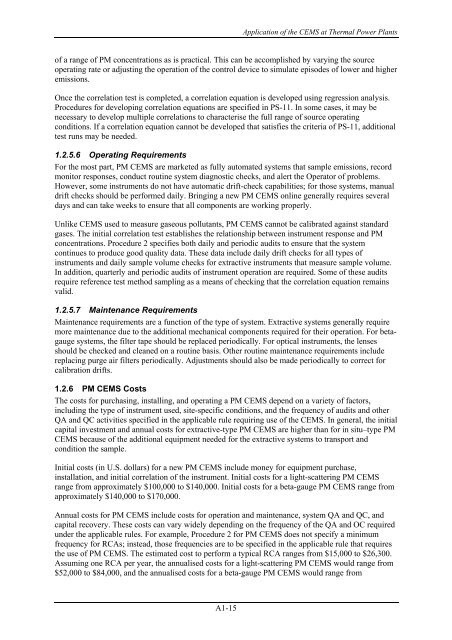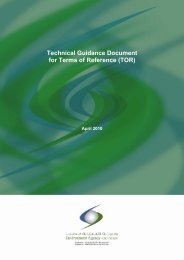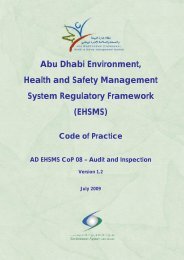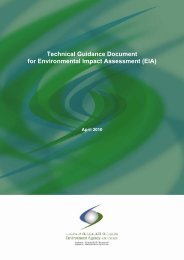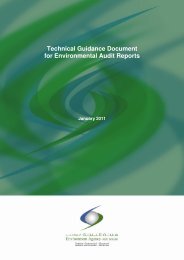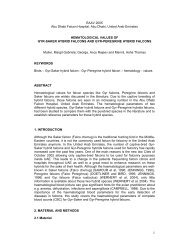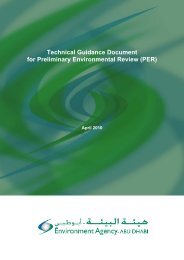Standard Operating Procedure (SOP) for Compliance Monitoring ...
Standard Operating Procedure (SOP) for Compliance Monitoring ...
Standard Operating Procedure (SOP) for Compliance Monitoring ...
Create successful ePaper yourself
Turn your PDF publications into a flip-book with our unique Google optimized e-Paper software.
Application of the CEMS at Thermal Power Plants<br />
of a range of PM concentrations as is practical. This can be accomplished by varying the source<br />
operating rate or adjusting the operation of the control device to simulate episodes of lower and higher<br />
emissions.<br />
Once the correlation test is completed, a correlation equation is developed using regression analysis.<br />
<strong>Procedure</strong>s <strong>for</strong> developing correlation equations are specified in PS-11. In some cases, it may be<br />
necessary to develop multiple correlations to characterise the full range of source operating<br />
conditions. If a correlation equation cannot be developed that satisfies the criteria of PS-11, additional<br />
test runs may be needed.<br />
1.2.5.6 <strong>Operating</strong> Requirements<br />
For the most part, PM CEMS are marketed as fully automated systems that sample emissions, record<br />
monitor responses, conduct routine system diagnostic checks, and alert the Operator of problems.<br />
However, some instruments do not have automatic drift-check capabilities; <strong>for</strong> those systems, manual<br />
drift checks should be per<strong>for</strong>med daily. Bringing a new PM CEMS online generally requires several<br />
days and can take weeks to ensure that all components are working properly.<br />
Unlike CEMS used to measure gaseous pollutants, PM CEMS cannot be calibrated against standard<br />
gases. The initial correlation test establishes the relationship between instrument response and PM<br />
concentrations. <strong>Procedure</strong> 2 specifies both daily and periodic audits to ensure that the system<br />
continues to produce good quality data. These data include daily drift checks <strong>for</strong> all types of<br />
instruments and daily sample volume checks <strong>for</strong> extractive instruments that measure sample volume.<br />
In addition, quarterly and periodic audits of instrument operation are required. Some of these audits<br />
require reference test method sampling as a means of checking that the correlation equation remains<br />
valid.<br />
1.2.5.7 Maintenance Requirements<br />
Maintenance requirements are a function of the type of system. Extractive systems generally require<br />
more maintenance due to the additional mechanical components required <strong>for</strong> their operation. For betagauge<br />
systems, the filter tape should be replaced periodically. For optical instruments, the lenses<br />
should be checked and cleaned on a routine basis. Other routine maintenance requirements include<br />
replacing purge air filters periodically. Adjustments should also be made periodically to correct <strong>for</strong><br />
calibration drifts.<br />
1.2.6 PM CEMS Costs<br />
The costs <strong>for</strong> purchasing, installing, and operating a PM CEMS depend on a variety of factors,<br />
including the type of instrument used, site-specific conditions, and the frequency of audits and other<br />
QA and QC activities specified in the applicable rule requiring use of the CEMS. In general, the initial<br />
capital investment and annual costs <strong>for</strong> extractive-type PM CEMS are higher than <strong>for</strong> in situ–type PM<br />
CEMS because of the additional equipment needed <strong>for</strong> the extractive systems to transport and<br />
condition the sample.<br />
Initial costs (in U.S. dollars) <strong>for</strong> a new PM CEMS include money <strong>for</strong> equipment purchase,<br />
installation, and initial correlation of the instrument. Initial costs <strong>for</strong> a light-scattering PM CEMS<br />
range from approximately $100,000 to $140,000. Initial costs <strong>for</strong> a beta-gauge PM CEMS range from<br />
approximately $140,000 to $170,000.<br />
Annual costs <strong>for</strong> PM CEMS include costs <strong>for</strong> operation and maintenance, system QA and QC, and<br />
capital recovery. These costs can vary widely depending on the frequency of the QA and OC required<br />
under the applicable rules. For example, <strong>Procedure</strong> 2 <strong>for</strong> PM CEMS does not specify a minimum<br />
frequency <strong>for</strong> RCAs; instead, those frequencies are to be specified in the applicable rule that requires<br />
the use of PM CEMS. The estimated cost to per<strong>for</strong>m a typical RCA ranges from $15,000 to $26,300.<br />
Assuming one RCA per year, the annualised costs <strong>for</strong> a light-scattering PM CEMS would range from<br />
$52,000 to $84,000, and the annualised costs <strong>for</strong> a beta-gauge PM CEMS would range from<br />
A1-15


